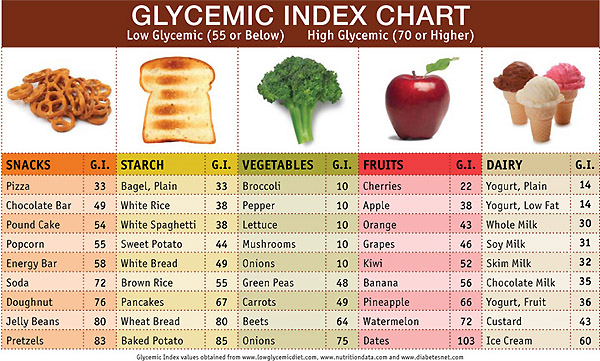GI – Glycemic Index – I am in no
doubt that you have seen this phrase in the media, so today we look at what GI
is, and how it can help you keep your energy stores up.
GI stands for “Glycemic Index”
and this is a scale or measuring system that scientists have devised to measure
the amount of sugar within different food stuffs and how quickly that sugar
gets into your blood stream. The GI
scale is set against one unit of Glucose – or sugar – which is equivalent to
one piece of sliced white bread. So a GI of 100 means that you food stuff
enters your blood stream at the same rate as 1gm of white sugar – that is
quickly!! 1g of sugar has 4 calories,
and 1g fat has 9 calories.
So some food stuffs have what is known as a
high GI which means that they have an index or “rating” of 70 or above. A
Medium GI would be 56-69 and a Low GI of less than 55. There are of course variations – for example
a ripe banana would have a higher GI than an unripe one. A potato can have a
high GI by the way it is cooked or how long it has been out of the ground. French bread made with the type of flour that
they use in France has a lower GI than some of the “French Bread” we can buy
here...etc
You also then need to look at the
“wrapping” of the food – brown bread with the wholemeal still in it will
have a lower GI than white bread. Brown
Rice over white rice etc – but also what you cook the food with. So if you have
protein or fat in your meal, then it slows down the absorption of sugar. Eating pudding after a meal is better for you than eating it as a snack.
When we eat food, it tends to
have two pathways – store in fat cells, or use as energy. As humans we tend to use the first pathway (i.e.
fat storage) and it seems that high GI foods tend to do just that with Low GI
foods following the second pathway...infact, it can be seen that high GI foods
also tend to stimulate fat storage and increase insulin levels...increased
insulin levels stops the use of fat as a source of energy by inhibiting the enzymes
that use fat when you are exercising.
In case you have not cottoned on
to the benefits of low GI or why that sugar snack “doesn’t matter” then don’t
forget that there is significant evidence that a diet that is rich in low GI
food has a positive effect on health and reduces the risk of conditions such as
diabetes, coronary heart disease or macular degeneration as well as being
linked to the ability to maintain a healthy weight.
At the end of the day, try to eat
as much of your food from a low GI source.
It will help release the blood glucose into your system more slowly,
which is much better if you are trying to lose weight and much better for your
overall health – mainly due to the insulin response that a high GI gives. We will look at the Insulin Response on a
later post. You will find it easier to
control your weight if you eat more low GI food – your cholesterol levels will be better, you
will feel less hungry between meals, it will provide you with fab energy levels
so that you can train hard as well.
The internet, as always, has plenty of information on what food to eat, recipes
etc and we will look at Glycemic Load (GL) and Insulin Load later (IL).
In the meantime, eat well, eat
clean, do exercise and get plenty of sleep J



No comments:
Post a Comment